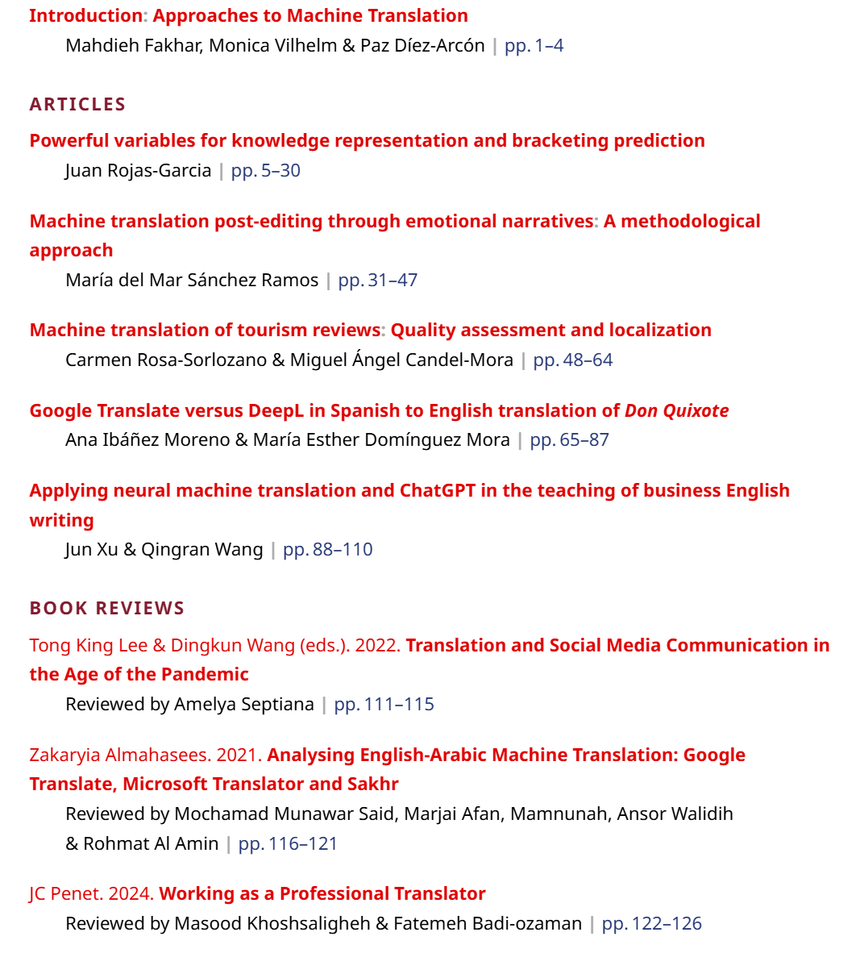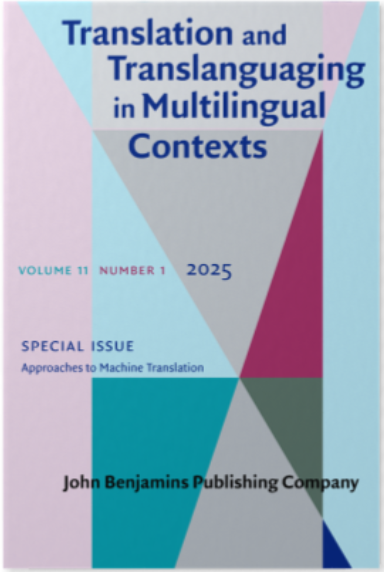|
期刊动态 | Translation and Translanguaing in Multilingual Contexts更新
小编速览 Translation and Translanguaging in Multilingual Contexts 2025年第1期聚焦机器翻译主题,共刊5篇文章。首篇探讨术语学中命名河流的语义标注与三元复合词预测;次篇研究实习译者对机器翻译与译后编辑的情感反应;第三篇分析旅游评论的机器翻译质量与本地化需求;第四篇对比Google Translate与DeepL在文学翻译中的表现;末篇由中国政法大学学者探讨神经机器翻译与ChatGPT在商务英语写作教学中的应用。本期为翻译学与多语实践研究提供新视角。
Translation and Translanguaging in Multilingual Contexts一年3期
Translation and Translanguaging in Multilingual Contexts
本期是机器翻译主题专刊,共刊登5篇文章,其中1篇出自华人学者。第一篇文章属于属于术语学,知识获取对于专业翻译至关重要,而专业术语在术语知识库中的表征是重中之重。本文基于框架术语学,探讨如何对提及命名河流的句子进行谓词-论元结构的语义标注。研究结果表明,该方法通过动词词域、语义角色和语义类别等语义变量,为理解专业文本中命名河流使用的知识结构提供新知。第二,本研究探索如何通过分析三元复合词与命名河流共同作为论元的句子中所编码的语义信息,来预测三成分多词术语的括号划分方式。基于词域、语义角色和语义类别这三个语义变量,本文成功构建了两个能够准确预测三元复合词的机器学习模型。第二篇文章译后编辑、翻译教学,目前鲜有研究探讨实习译者对机器翻译(MT)与译后编辑(PE)的情感反应如何影响其在翻译实践中使用这些工具的动机。理解并管理学生的情感,对于将MT与PE全面融入翻译培训体系、为学生职业发展做好充分准备至关重要。本文基于先前将情感叙事分析应用于译者技术体验的研究(Koskinen与Ruokonen,2017;Ruokonen与Koskinen,2017),采用情感叙事方法,探究35名西班牙翻译专业本科生对MT与PE的情感反应。参与者被要求以“情书”或“分手信”的形式撰写一封致MT的情感叙事文本。总体而言,参与者对MT与PE的态度偏向积极而非消极:35份情感叙事中,包含20封情书与15封分手信。主题分析揭示了学生叙事中的两大核心主题:(1)对MT译文的满意度;(2)MT的效率。这些探索性发现呼应了Yang与Wang(2019)的研究发现,即需进一步研究影响学生使用MT意愿的因素及其后续效应。研究结果亦可为教学实践提供参考,帮助翻译教师更好地理解激励学生在翻译实践中使用MT的关键动因。第三篇文章机器翻译质量评估、用户生成内容(UGC)翻译。旅游门户网站(如Tripadvisor)上的评论。许多作者一致认为,评论的信任度和可信度作为UGC最重要的特征。本文从本地化的角度分析用户生成内容的神经机器翻译的行为,检查机器翻译质量是否仅取决于语言或文体特征,或者本地化所需求(如目标用户语言和文化适应性)也起着决定性作用。作者编制了一个英西双语平行语料库,包含从Tripadvisor检索到的250条评论。这些评论最初是用英语撰写的,并通过机器翻译处理成西班牙语,根据机器翻译质量量表和本地化指南中的两个参数——正确性和可接受性——来评估机器翻译输出的质量。第四篇本文分析了神经机器翻译在文学翻译中的有效性,特别是针对惯用搭配的翻译,衔接错误等均是最常见的问题。本文对世界文学经典《堂吉诃德》(西班牙语名为《El ingenioso hidalgo don Quijote de la Mancha》)第一章的翻译进行了对比分析,重点关注惯用搭配。我们将汤姆·拉思罗普(Tom Lathrop)的《堂吉诃德》人工翻译版本与当今两大神经机器翻译系统——谷歌翻译和DeepL的译文进行了对比,以查看哪种系统能够提供更准确的结果。结果证实,神经机器翻译能够提供高度可靠的结果。在定量层面,确定DeepL和谷歌翻译哪个系统更好的差距非常小。DeepL在准确性和召回率方面得分更高,但在BLEU指标中,谷歌翻译得分为28.10,DeepL得分为26.63。从定性层面和主观角度来看,本文发现DeepL的翻译比谷歌翻译更流畅、更自然。第五篇文章来自中国政法大学徐珺和教授和王清然博士,评估NMT技术和ChatGPT在金融、经济和工商管理三个商务领域的英语作为外语(EFL)写作教学中的应用,为语言教学中技术应用的相关文献做出了贡献。通过构建六个可比语料库,这些语料库由学生的直接写作和基于机器翻译文本的后编辑写作组成,作者考察了NMT是否能够帮助提高学生在商务英语写作课程中的表现,以及ChatGPT是否能够补充NMT的功能。统计分析表明,总体而言,NMT可以提高学生的学术写作能力,但对于不同专业的学生,其提升效果在不同维度上有所不同。具体而言,对于金融专业的学生,NMT可以在词汇、句法层面和写作规范上提高他们的学术写作能力,但会对文章的结构维度产生负面影响。对于经济专业的学生,NMT的提升效果主要集中在句法、连贯性和写作规范等维度上;而对于工商管理专业的学生,NMT主要在内容、连贯性和写作规范等维度上发挥作用。对于NMT表现不佳的维度,我们对学生论文写作的分析表明,ChatGPT可以通过改进和为学生提供反馈来补充NMT的功能。通过研究NMT和ChatGPT在EFL写作教学中的应用,并提出它们在商务英语写作教学中可能的使用方向,为语言教学中技术应用的现有研究增加了价值。Powerful variables for knowledge representation and bracketing predictionJuan Rojas-Garcia | University of Granada The acquisition of knowledge is essential for specialized translation, and the representation of specialized phraseology in terminological knowledge bases facilitates this process. The aim of this study is two-fold. Firstly, it describes how the semantic annotation of the predicate-argument structure of sentences mentioning named rivers can be addressed from the perspective of Frame-based Terminology. The results show that this approach, including the semantic variables of verb lexical domain, semantic role, and semantic category, provides valuable insights into the knowledge structures underlying the usage of named rivers in specialized texts. Secondly, this study explores whether the bracketing of a three-component multiword term can be predicted from the semantic information encoded in the sentence where the ternary compound and a named river are used as arguments. The semantic variables of lexical domain, semantic role, and semantic category allowed us to construct two machine-learning models capable of accurately predicting ternary-compound bracketing.
Machine translation post-editing through emotional narratives A methodological approach María del Mar Sánchez Ramos | University of Alcalá Machine translation (MT) and post-editing (PE) have become increasingly common in translation training (Guerberof-Arenas and Moorkens 2019; Sánchez Ramos 2022). However, few studies have explored how trainee translators’ emotional responses to MT and PE impact their motivation to incorporate these tools in their translation practice. Understanding and managing the emotions of students is crucial to integrating MT and PE within translator training as a whole, and to fully preparing students for their professional careers. Building on previous studies applying emotional narrative analysis to translators’ experiences with technology (Koskinen and Ruokonen 2017; Ruokonen and Koskinen 2017), this article explores the emotional responses of a group of 35 Spanish undergraduate translation students to MT and PE using an emotional narrative methodology. Participants were asked to write an emotional narrative in the form of either a love letter or a break-up letter addressed to MT. Overall, participants were found to be more positive than negative in their attitude towards MT and PE. Among the 35 emotional narratives, there were 20 love letters and 15 break-up letters. Thematic analysis revealed two main themes in the students’ narratives relating to (1) satisfaction with MT output and (2) the efficiency of MT. These exploratory findings reinforce Yang and Wang’s (2019) call for more research into what factors contribute to students’ intention to use MT and the consequent effects of using MT. They can also inform pedagogy so that translator trainers better understand the factors that motivate students to incorporate MT in their translation practice.
Machine translation of tourism reviewsQuality assessment and localizationCarmen Rosa-Sorlozano | Universitat Politècnica de ValènciaMiguel Ángel Candel-Mora | Universitat Politècnica de ValènciaMachine translation (MT) has surpassed all quality expectations and its use has increased exponentially in recent years (Forcada 2017; Sánchez-Gijón, Moorkens, and Way 2019). One of the most frequent MT applications is the translation of user-generated content (UGC) and, more specifically, reviews on tourism portals such as Tripadvisor. Several authors agree that the degree of trust and credibility of a review, as the most important characteristics of UGC, depends largely on the perceived naturalness and authenticity of its writing (Pollach 2006; Schemmann 2011; Vásquez 2014). The review’s influence on the product’s reputation and on the purchase decision-making of future users has been fully demonstrated. Since review platforms make reviews available to users in different languages translated by MT, the quality of MT output should be studied from the point of view of the text’s adaptation to the requirements of a specific audience and market, following the principles elaborated in localization studies. The aim of this paper is to analyze the behavior of neural MT of user-generated content from the perspective of localization to check whether MT quality depends exclusively on linguistic or stylistic aspects or whether the aspects studied by localization, such as linguistic and cultural appropriateness for the target user, also play a decisive role. We compiled an English-Spanish parallel corpus consisting of 250 reviews retrieved from Tripadvisor. The reviews were originally written in English and MT processed into Spanish. Then the quality of the MT output was evaluated following two parameters: correctness and acceptance according to MT quality scales and localization guidelines.
Google Translate versus DeepL in Spanish to English translation of Don QuixoteAna Ibáñez Moreno | Universidad Nacional de Educación a Distancia (UNED)María Esther Domínguez Mora | Universidad Nacional de Educación a Distancia (UNED)This paper analyses the effectiveness of neural machine translation when applied to literary translation and, more specifically, to the translation of collocations, one of the most difficult aspects in machine translation (Corpas-Pastor 2015; Shraiden and Mahadin 2015). Literary translation continues to constitute one of the biggest challenges for machine translation (Toral and Way 2018), where cohesion errors are amongst the most frequent (Voigt and Jurafsky 2012). A comparative analysis of the translation of the first chapter of the world literature masterpiece El ingenioso hidalgo don Quijote de la Mancha — known as Don Quixote in English — was carried out, paying close attention to collocations. The human translation done by Tom Lathrop (Don Quixote) was compared to the target texts obtained with the two biggest neural machine translation systems today, Google Translate and DeepL, to see which provided more accurate results. The results confirm that neural machine translation offers highly reliable results. On a quantitative level the margins are very narrow when determining which system, DeepL or Google Translate, is better. DeepL scored better in terms of accuracy and recall, but in the BLEU metrics Google Translate scored 28.10 and DeepL 26.63. On a qualitative level and from a subjective point of view, we found DeepL’s translation to be somewhat more fluid and natural than Google Translate’s.
Applying neural machine translation and ChatGPT in the teaching of business English writingJun Xu | China University of Political Science and LawQingran Wang | China University of Political Science and LawAs language teaching becomes more complex and diverse, there has been a rapid increase in the demand for advanced technology, driving the widespread adoption of neural machine translation (NMT) and ChatGPT in the field. This study contributes to the literature on the use of technology in language teaching by evaluating the application of NMT technology and ChatGPT in teaching English as a foreign language (EFL) writing in three business fields: finance, economics, and business administration. By building six comparable corpora consisting of students’ direct-writing and post-edited writing based on machine-translated texts, we examined whether NMT can help improve students’ performance in business English writing classes, and whether ChatGPT can complement NMT. Our statistical analyses show that in general, NMT can enhance the proficiency of students’ academic writing, but its improvement effect works on different dimensions for those students studying in different majors. Specifically, for finance students, NMT can improve their academic writing at the word and syntax levels and mechanics, while it harms the organizational dimension. For students in economics, the improvement effect of NMT mainly focuses on enhancing the dimensions of syntax, cohesion, and mechanics, whereas for students in business administration, NMT works primarily on the dimensions of content, cohesion, and mechanics. As for the dimensions where NMT performs poorly, our analysis of students’ essay writing shows that ChatGPT can complement NMT by making improvements and providing feedback to students. Our paper adds value to existing research on the use of technology in language teaching by investigating the application of NMT and ChatGPT in teaching EFL writing, and by proposing potential directions for their use in the teaching of writing business English.
|
|



















